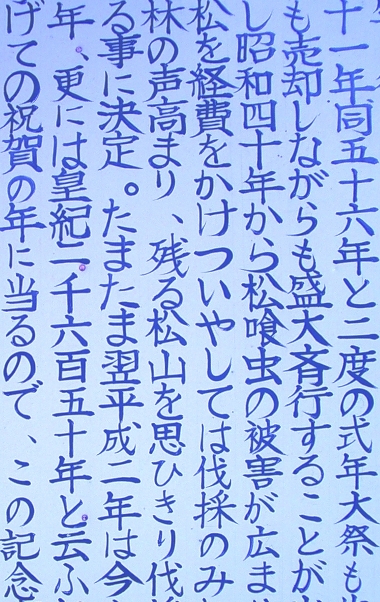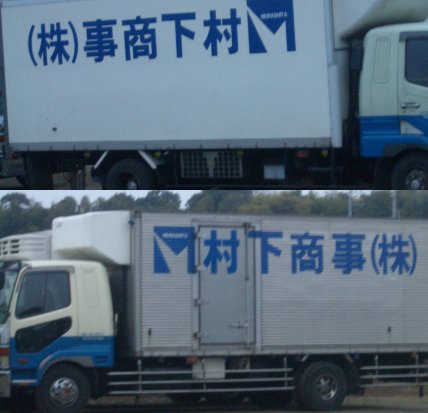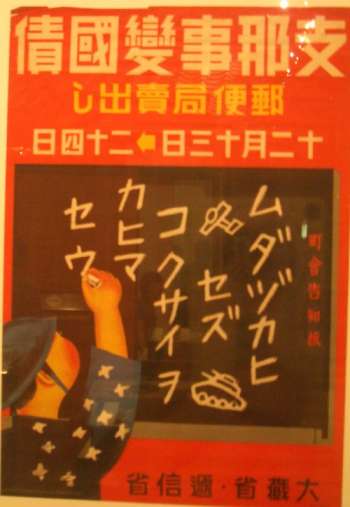
 |
| Vertical Japanese writing |
|---|
| Photo credit: Timothy Takemoto / CC licence |
There are basically two directions in which Japanese can be written, from top to bottom, called tategaki (縦書き), and from left to right, called yokogaki (横書き)
Traditionally, Japanese was written like traditional Chinese, from top to bottom in columns, with each new column starting to the left of the preceding one. This format came from the traditional Chinese order, and the stroke order and direction of Chinese characters and kana is designed to facilitate writing in this manner.
In modern times, Japanese is also written horizontally from left to right, with successive rows going from top to bottom, in a manner identical to that of European languages such as English. This style is known as yokogaki. It began in the Meiji period (1868-1912) when the Japanese tried to print dictionaries for Western languages. Initially the dictionaries were printed in a mixture of horizontal Western and vertical Japanese text, which meant the book had to be rotated ninety degrees in order to read the Japanese. Because this was unwieldy, the idea of yokogaki came to be accepted. One of the first publications to partially use yokogaki was a German to Japanese dictionary called Shūchinsōzu Dokuwa Jisho (袖珍挿図独和辞書), "pocket illustrated German to Japanese dictionary" published in 1885 (Meiji 18).
Kanji and kana can be written horizontally or vertically, although there are some styles of kanji and kana, such as sōsho (see What are the different styles of Japanese lettering?), which are not suitable for horizontal writing. There are some small differences in orthography. In horizontal writing it is more common to use Arabic numerals, whereas kanji numerals are more common in vertical text. The chōon mark, ー, which indicates a long vowel, is written going downwards in tategaki and going sideways in yokogaki. Punctuation, for example the position of commas and full stops, also differs.
Where a text is written in yokogaki format, pages are read in the same order as English books, with the binding at the left and pages progressing to the right. Tategaki books are printed the other way round, with the binding at the right, and pages progressing to the left.
Furigana (see What is furigana?), follow the direction of the main text:
|
or |
|
Romanization is usually written horizontally, or turned sideways when it appears in vertical text, with the base of the characters on the left.
Both tategaki and yokogaki are used in Japan today. Tategaki is the usual form for novels, newspapers, and comics. Because it goes downwards, tategaki is invariably used on the spines of books. Newspapers combine the two forms, but usually are mostly tategaki and open with the centre fold on the right.
Yokogaki is used for academic texts in subjects such as mathematics or other sciences which require formulas, and for foreign language textbooks. Scientific and mathematical texts are usually written horizontally, since in vertical writing formulas must be turned sideways, making them more difficult to read.
Similarly, English language textbooks, which contain many English words, are usually printed in yokogaki. This is not a fixed rule, however, and English words are also often printed sideways in tategaki texts.
Business cards in Japan (meishi) are sometimes printed vertically in Japanese on one side, and horizontally in English on the other. Postcards and handwritten letters may be arranged horizontally or vertically, but the more formal the letter the more likely it is to be written vertically. Envelope addresses are usually vertical, with the address on the left and the name of the person in the exact centre of the envelope. (See How does the Japanese addressing system work? for more on the Japanese address system.)

|
|
Right-to-left and left-to-right
writing on a truck. |
|---|
Right-to-left horizontal writing is seen on signs, on the right-hand side of vehicles, and on the right-hand side of stands selling food at festivals. It is also used to simulate archaic writing, for example in reconstructions of old Japan for tourists.
 |
| World War 2 poster written right to left |
|---|
Historically, vertical writing was the mainstream, and horizontal writing was only used where vertical text could not fit, for example a horizontal sign such as over the gates of temples. This was essentially a special form of tategaki, with one-character columns going from right to left. In the pre-WW2 era, single-column right-to-left writing was commonly used where left-to-right writing has now become standard. For example, right-to-left horizontal writing was used in newspaper captions and titles.
At the very beginning of the change to yokogaki, in the Meiji period (1868-1912), there was a short-lived form called migi yokogaki (右横書き), "right yokogaki", in contrast to hidari yokogaki (左横書き), "left yokogaki", the current form. This resembled the right-to-left horizontal writing style of languages such as Arabic or Hebrew with line breaks on the left hand side of the page. It was probably based on the traditional single-column right-to-left writing. This form was never widely used, and has not survived.
Japanese comics usually use tategaki for text. In this case, the reading order for cells is usually right to left and then downwards. Page ordering is the same as books that use vertical direction: from right to left. Frames that are chronologically before or after each other use less spacing in between as a visual cue.
In the case of yokogaki manga, with horizontal text, the reading order of the cells is from left to right, in the same way as in Western comics, and the book opens with the binding on the left.
Computer text is usually presented in yokogaki format. Japanese word processors usually have facilities to write tategaki format, but most computer terminals do not display in this format.
Copyright © 1994-2022 Ben Bullock
If you have questions, corrections, or comments, please contact Ben Bullock or use the discussion forum / Privacy policy

|

|

|

|

|
| Book reviews |
Convert Japanese numbers |
Handwritten kanji recognition |
Stroke order diagrams |
Convert Japanese units |